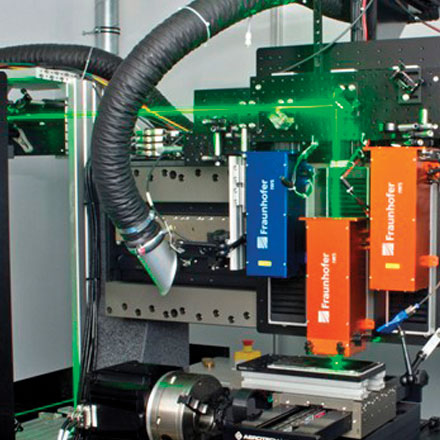|
Thursday, October 15, 2020 |
|

|

|
Success in a specific market depends on meeting the right technical requirements. As demand increases, it becomes necessary to develop and establish new manufacturing processes to produce functional surfaces at high processing speeds and low costs. In this webinar, Udo Klotzbach, Ph.D., will highlight three application fields of direct laser writing and patterning for surface modification – automotive, photovoltaic, and life sciences – and the challenges associated with each, as well as projections of new goals to meet manufacturing demands.
For automotive applications, wear on moving surfaces reduces the lifetime of components or the entire system. Losses due to friction represent energy quantities that go unused when two moving surfaces interact. It is estimated that an average economic loss of approximately 2% to 7% of the annual gross domestic product is due to friction and wear. Significant savings potentials in energy and materials arise for systems that are otherwise technically mature when the tribological – that is, friction- and wear-related – parameters of mechanically interacting surfaces are influenced by patterning.
Another application is developing technology for organic electronic elements on flexible substrates such as organic photovoltaic (OPV) foils. Technologies such as direct laser scribing processes for flexible substrates coated with such ultrabarrier systems are necessary. Its clear aim is showing a way to large-area, large-volume, OPV production using laser scribing in R2R processes. Still, its topics are not less demanding – for cost-efficient production of OPV, the web width needs to be significantly increased from 300 mm today to at least 1200 mm. Further, technology must be applicable to a web speed of 5 m/s. For reaching this goal, new technologies on fast laser scribing need to be developed, and new high-speed beam deflection systems will be needed to adapt for R2R processing.
For life science applications, surface engineering of biomedical materials is considered an essential technology to adapt the cell and bacteria adhesion on implant surfaces in the human body and medical products. Specific topographic features can have both cell adhesion-promoting and bacteria-repellent properties. Depending on the application, one or both at the same time are required. Typical materials used for implants and medical products are titanium and several polymers. Common methods to change the surface properties of these materials are either cost-intensive (e.g., coatings) or not efficient due to multistep processes (e.g., grain blasting and etching).
Who Should Attend:
Engineers, technicians, R&D scientists, marketing specialists, and others in the automotive, photovoltaic, and/or life science fields interested in learning more about laser writing manufacturing improvements. Anyone whose work involves direct laser writing and patterning, especially its applications for automotive components, OPVs, and medical implants.
About the Presenter:
Klotzbach, of the Fraunhofer Institute for Material and Beam Technology in Dresden, grew up in Germany and received his degree in electrical engineering and information technology from the Technical University of Dresden in 1995. Afterward, he worked at Fraunhofer Institute Integrated Circuit in Dresden as an IC designer; Thuringian State Chancellery in Erfurt as a team leader in new media and communication technology; Technical University of Dresden and the Fraunhofer Institute for Material and Beam Technology in Dresden as assistant to the chair of laser and surface engineering; and the Ministry for Economic Affairs and Labour of Saxony in Dresden as a consultant for technology funding. Since 2001, he has worked on laser microprocessing at the Fraunhofer Institute of Material and Beam Technology in Dresden. In 2006, he obtained his Ph.D. from the Technical University of Vienna. Currently, he is responsible for the following business unit areas at Fraunhofer: micromaterial processing, surface functionalization, and micro- and biosystems engineering. Since 2020, Klotzbach has been giving lectures on biomicrosystems technology at the University of Applied Science HTW in Dresden.
Klotzbach has worked on the Committee of the International Symposium on Laser Precision and Microfabrication (LPM) in 2019/2020; for the Japan Laser Processing Society in Japan; as conference chair of SPIE, Photonics West, Laser-Based Micro- and Nano-Processing in San Francisco; on the Program Committee of SPIE, Photonics Europe (2020); in the Industrial Manufacturing and Quality working group, Photonics 21, in Brussels; and, since 2004, in the European Photonics Industry Consortium (EPIC) in Paris and Brussels.
|
|
|
|
Date: Thursday, October 29, 2020
Time: 10:00 AM - 11:00 AM EDT
Space is limited. Reserve your Webinar seat now at: https://attendee.gotowebinar.com/register/4821204963717979408
After registering you will receive a confirmation email containing information about joining the Webinar.
|
|
|
SYSTEM REQUIREMENTS
Operating System
Windows® 7 or later, Mac OS® X 10.9 or later, Linux®, Google ChromeTM OS
AndroidTM OS 5 or later, iOS® 10 or later
Web Browser
Google ChromeTM (most recent 2 versions)
Mozilla Firefox® (most recent 2 versions)
Mobile Devices
AndroidTM 5 or later
iPhone® 4S or later
iPad® 2 or later
Windows Phone® 8+, Windows® 8RT+
|
|
|
|
.: More from Photonics Media
|
|
|
|